Family : Fringillidae

Text © Dr. Gianfranco Colombo

English translation by Mario Beltramini
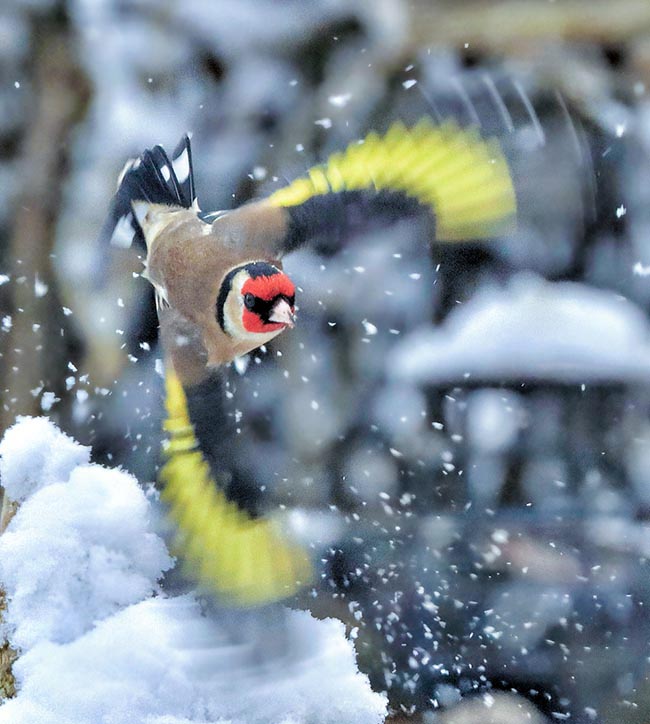
A fkutter of wing and a gay dot of colour on the snow in mid winter © Nick Brischuk
If the poor Goldfinch could speak and express to our good Lord, its creator, some considerations about its terrestrial situation, I think that it could have something to say.
Maybe it would deny Him for having made it too beautiful and colourful, too cheerful and lively, too nice and affectionate as it is likely that if he had not gotten all these advantages it should have had an easier life!
In fact, these characteristics have placed it at the top of the list of those species so much battered by mankind in the name of that alleged love to the animals, so much to put them in a cage for all their life, for the same pleasure of keeping a nice small bird in a cage.
As a matter of fact, since always, the Goldfinch is caught in enormous quantities in all the corners of the Mediterranean, of Middle East and in Asia, for this insane purpose and is still now the object of an indefinite and illegal trade.
In the past things were even worse, so much that also in England, until the second mid of the XIX century, this bird was subject to a hunting that, if not interrupted, would even lead to the extinction of the species.
The popularity of the Goldfinch increased considerably during the Victorian era and the demand increased so strongly that began the first symptoms of a danger for the species. We read in a report given to the English Parliament, that in 1860 a capture of 132.000 individuals took place just in one limited area and that on the next year it was reported the case of a boy who, in just one day, seized almost 500 of them.
It was clear that with this pace they would have encountered remarkable problems for the species, hence laws were emitted in defense of this small little bird. At that time, were used nets, birdlime, and snares of every kind, the same means used nowadays by the Mediterranean poachers who, imperturbable and often not severely punished, go on indefatigably to persecute this species.
Most assert that the interest for this bird stands in the song it emits persistently and continuously that cheers for whole days during all the summer as well as due to the affections that matures towards its jailers.
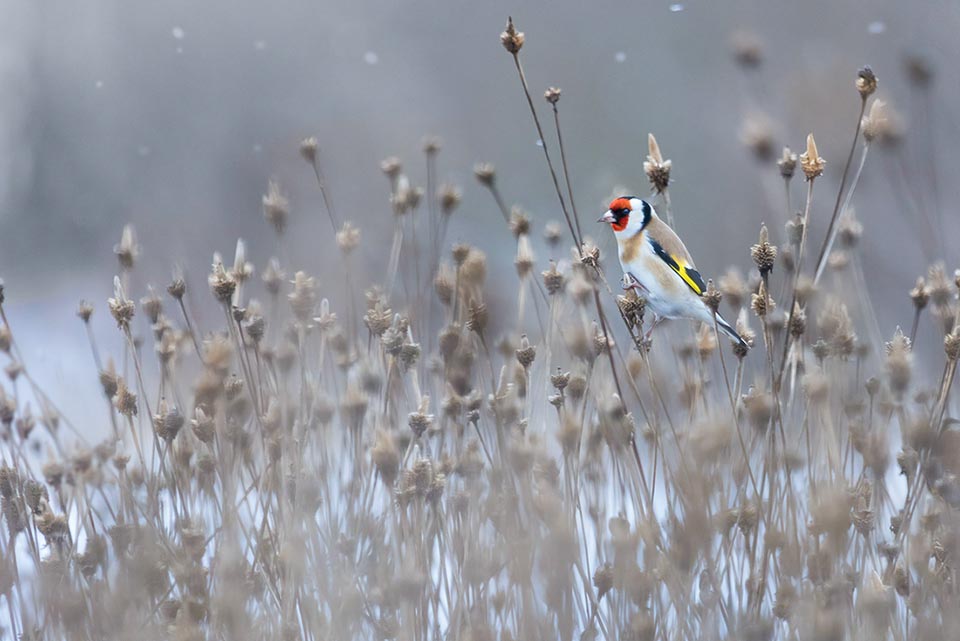
It’s a Goldfinch (Carduelis carduelis), resident in most Europe, unlike the Asian and Russian subspecies obliged to migrate due to cold © Piotr Pogoda
In reality, if it is even true that it displays an unexpected cordiality towards the one who has caged it , conversely, for its song the Goldfinch does not show those singing characteristics typical of melodious birds or with a stentorian voice. The song of the Goldfinch is a mix of short high-pitched and warbling trills, at times even melodic but spaced by rapid and dissonant strophes, spaced with quick dry trills, that have nothing to do with the full and tonal melody of a Nightingale (Luscinia megarhynchos) or of a Blackcap (Sylvia atricapilla).
It will also be a pleasant song for many, but surely is the livery colouring that drops the choice on this small bird, united to the ease of breeding. It would not be so easy to keep in a cage a nightingale or a blackcap, birds that require care and food not always available during the year.
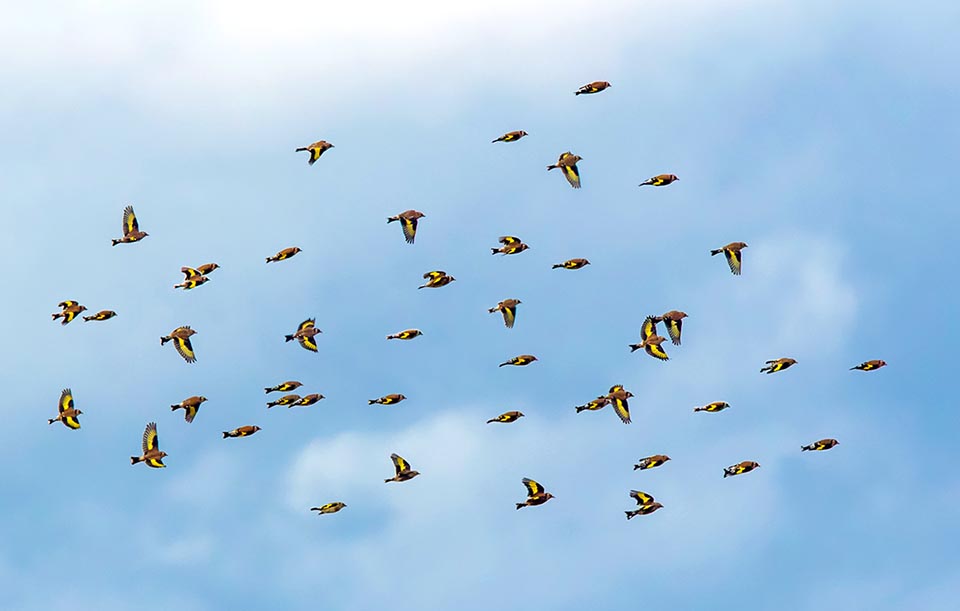
Social bird, subject in the temperate climates only to short and erratic seasonal movements © Michel Dopré
The Goldfinch (Carduelis carduelis Linnaeus, 1758) belongs to the order of the Passeriformes and to the family of the Fringillidae, group that includes an infinite number of small birds diffused in all continents and considered as among the most cheerful and colourful of the winged world.
The etymology of its scientific name, in this case a tautonym binomen, gets origin from the Latin epithet “carduus” = thistle, main food of this bird.
Some international names are, in English, Goldfinch, in German Stieglitz carduelis, in Spanish Jilguero, in French Chardonneret élégant, in Portuguese Pintassilgo and in Italian Cardellino.
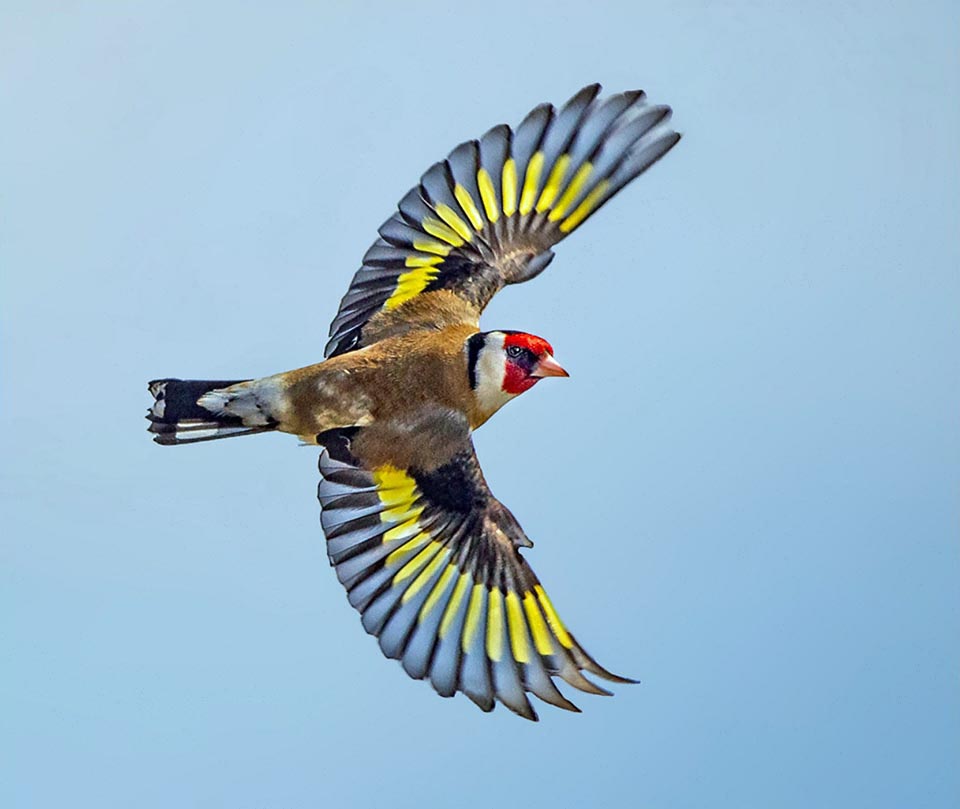
With an only 23 cm wingspan, stands among smallest fringillids: about 12 cm long, weighs only 15-25 g © Clive Brown
Being a very common bird, it has deserved an immense number of regional names around Europe, often rather folkloric, such as lavarin, raarì, raar, gardelin, gardein, cardillu, cardidd, in Italy, cardonille, cardine in France, and in the United Kingdom also goldie, gold linnet, redcap and King Harry’s Red Cap, in memory of a saying coined at the time of the Tudors to identify the variety of the colours of its livery, not inferior to the garments of a king, In this last country the term “goldfinch” is also used to indicate, in jargon, a wealthy person or someone who has made fortune, rightly for the many and remarkable characteristics typical of this species.
Zoogeography
The original distribution area of the Goldfinch is typically the Palearctic and includes Europe almost completely, Russia up to the Central Asian republics, Middle East, Iraq, Iran, Afghanistan and Pakistan and in Africa the western Mediterranean coasts and the Nile Valley.
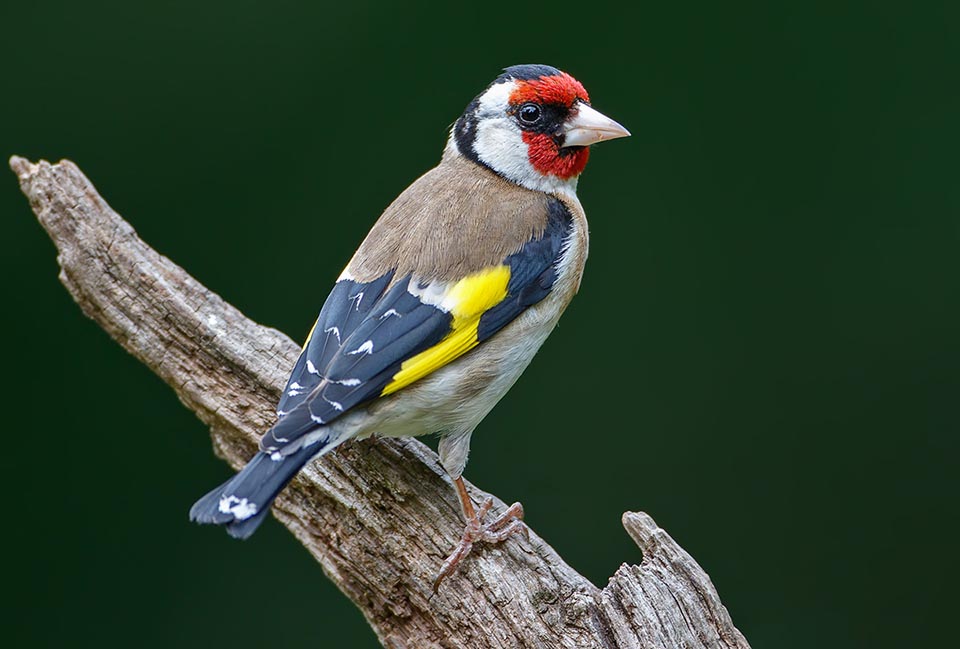
Fire red, intense yellow, cream, white and deep black, are the well matched colours of its elegant livery, sided by its gay character that renders it immediately pleasant. Conical bill, pointed and fine, that allows to take from the thistles and other herbaceous essences minute seeds that other birds could not be able to take © Kevin Agar
Roughly, it is missing north of the sixtieth parallel, therefore it is absent from the Scandinavian Peninsula, and parallelly eastwards over this limit. However, the ease of breeding and the introductions in the wild state in some faraway regions, made this small bird present also in Australia and in New Zealand, in both North and South Americas, and in Macaronesia.
Practically, the invasion has followed literally the migratory flows of the European populations, to which has remained rigidly attached. We must not forget that also the breeders and the lovers of these fringillids, have remarkably contributed to this diffusion as well as to experimenting with this species an endless series of crosses with other fringillids, especially canaries, churning out specimens of all shapes and shades just for the pleasure of seeing all colours! The famous British Finches.
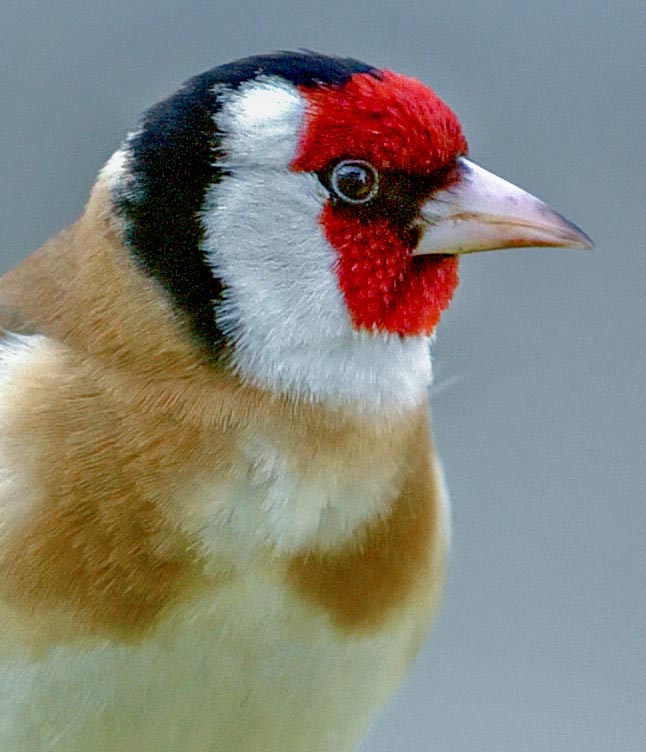
The sexes differ in the plumage for particulars that only experienced connaisseurs can perceive. In the adult male, here shown, the red facial mask embeds the eye, whilst in the females is slightly shorter © Gianfranco Colombo
The Goldfinch is one of the fringillids easiest to hybridize and for this reason we can surely affirm that in every corner of the world, or better, in any cage of the world, there is one specimen of this species.
Ecology-Habitat
Perhaps it would be simpler to observe where the thistles (Carduus spp.) grow for understanding what the ideal habitat of the Goldfinches is.
It is not that this little bird feeds only on the seeds of this essence, but it is indicative to know that where this plant is found, we can surely find these fringillids.
The Goldfinch is for most of the populations a species considered as resident, in particular the European ones that are subject to short and erratic seasonal movements more than to a real migration.
Conversely, the Asian and the Russian subspecies, also because of the rigid climate of central Asia winter, are subject to real migrations that lead them to totally leave their summer quarters to reach well distant southern or western areas.
This behavior has even determined the subdivision of this fringillid in two distinct strains: the carduelis, the European species and the caniceps, the Asian one, that have finally originated inside themselves an infinite number of subspecies.
The habitat of the Goldfinch is very varied and being present in an infinity of environments at times quite different from each other. It can be a totally bare and barren environment with low and not cultivated vegetation, full of herbaceous essences that produce an intense series of small seeds, or an even intensively cultivated country, also at monoculture but offering corners or borders with herbaceous essences or yet woods spaced by meadows, road embankments, gardens and public parks, vineyards and orchards.
Practically, it is present everywhere from the sea up to an altitude of about 1.200/1.500 m and from the Mediterranean thicket to the moors of North Europe. It is essential that in the surroundings there is also a source of water to which it will pay a visit several times during the day.
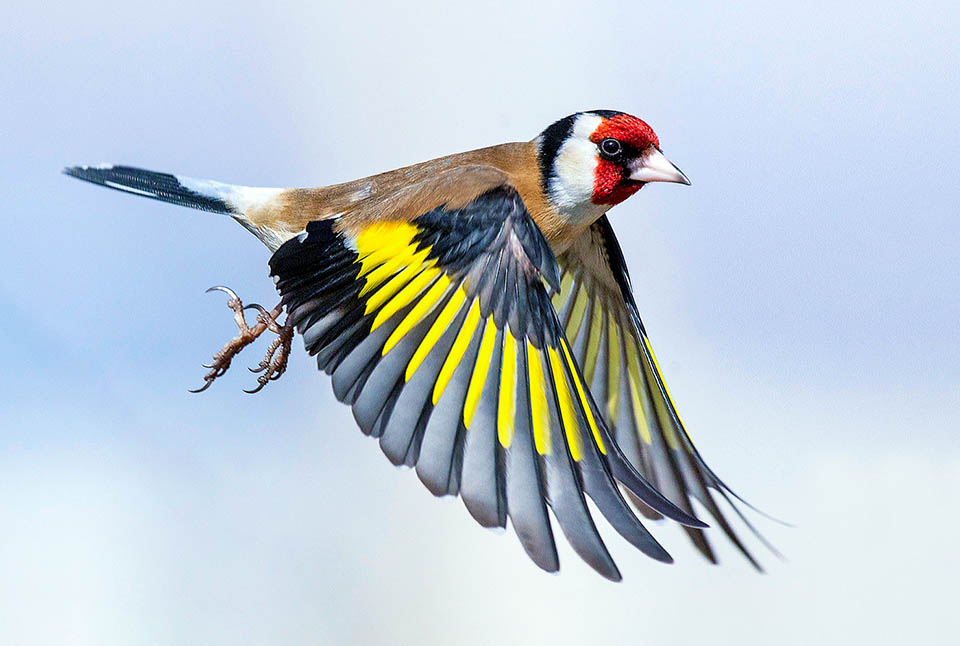
Goldfinch habitat is quite varied. It can be seen everywhere, from the sea to about 1.200-1.500 m of altitude, from the Mediterranean thicket to the North European moors © Mauro Pasquero
Morphophysiology
The livery of the Goldfinch is a real palette of colours! The facial mask is of a fire red colour, with a very white chinstrap band like a bib that unites on the head and the nape, both of a very black velvety colour.
The chest is of cream colour with the sides marked by a more brownish hazelnut colour more or less strong depending on the subspecies and that continues on the shoulders up to the rump that, instead, is white.
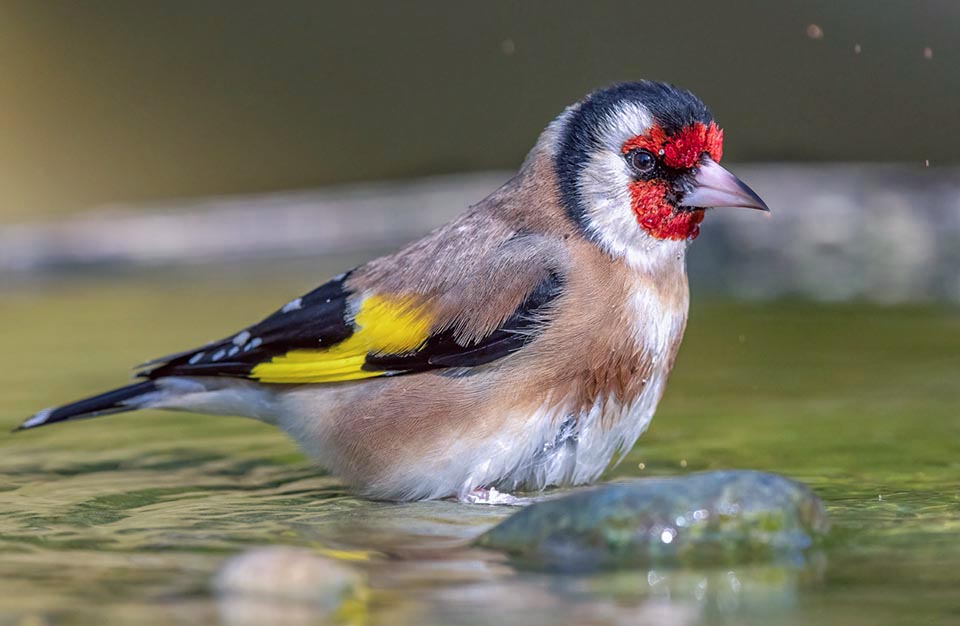
It is essential that around stands also a source of water that it will surely visit several times per day © Cimino Del Bufalo
Very black wings with a wide yellow band on the coverts and remiges with white dot on the terminal part of the feathers, both characters well visible when flying. Also tail with white dots on the central rectrices.
Fleshy pink paws and ivory coloured bill. Blackish eyes encircled by a black periocular ring.
The sexes do not differ in the plumage if not for small particulars that only the connoisseurs are able to perceive. The facial red of the male slightly exceeds the eyeball whilst it is minimally in the female, as well as the brownish dusting on the sides, less marked in the female.
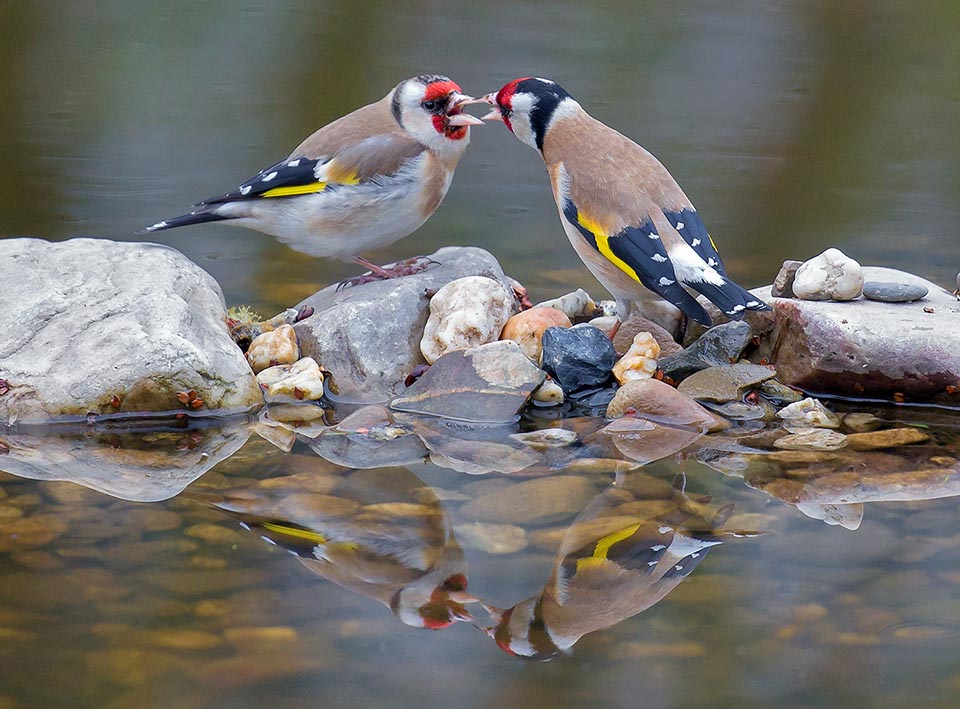
The Goldfinch is monogamous just for the reproductive time. On the right, the male, thanks to the murmur of water, has found a partner © Martha de Jong-Lantink
Conversely, the young are easy to recognize, on the contrary, they are so much different to look as belonging to another species: an inconspicuous livery. They are mostly greyish, without the red mask in face and only a minor hint of the yellow wing bands attributes them to the species. Within a few months they will then change the plumage, becoming indistinguishable and coloured like the adults.
The bill of the Goldfinch is conical and particularly pointed and so much fine to allow it to take off from the thistles and from other herbaceous essences, the minute seeds that other birds would not be able to catch. This characteristic gave to this bird a specialization that allowed it so strong development of its own populations. The Goldfinch is a very small fringillid, measuring only about 12 cm in length, a weight varying from 15 to 25 g and a wingspan of 23 cm.
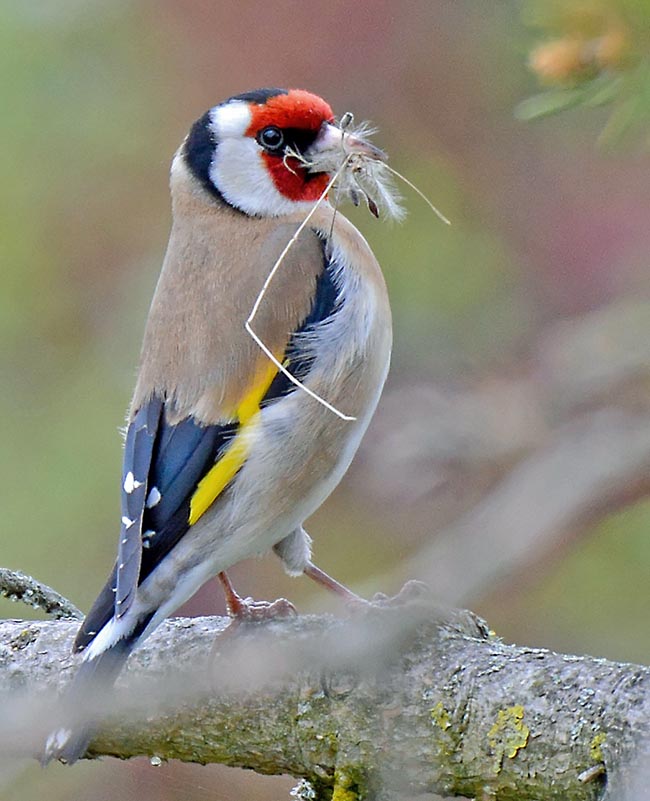
The female is charged of constructing the nest, whilst the male, here at work, carries most of the material © Benoit Lallement
The dimensions of this small bird however vary depending on the climate of the habitats frequented and sees the Asian populations developing measures well major than those of the western ones.
Very many subspecies have been determined, mainly linked to the sites of origin, for the most far-flung zones of its distribution area.
Some taxonomists already consider the subspecies C. c. caniceps, typical Asian form, as a separate species by detaching it from the nominal C. c. carduelis typical of the European continent and inside these two groupings, place all that infinite series of subspecies found in the occupied territories.
Just to recall some subspecies of European competence, we find the C. c. britannica (UK and North Sea), the C. c. tschusi (typical of Italy and relevant islands), the C. c. parva (Macaronesia, Iberian Peninsula and North Africa), the C. c. balcanica (Balkans and Turkey) and the C. c. carduelis in the rest of the European continent.
In Asia, geographically moving from west to east, we have the C. c. niediecki, C. c. brevirostris, C. c. colchica, C. c. volgensis, C. c. frigoris, C. c. paropanisi, C. c. subulata, C. c. ultima and the C. c. caniceps, the Himalayan Goldfinch, rightly the subspecies aspiring to become a species!
Ethology-Reproductive Biology
The nidification of the Goldfinch is something done in the most absolute discretion with such a secrecy to render almost impossible to to understand where it has placed the nest. We see it wandering around the garden during some days and then disappear, then we see it again on top of a branchlet, all happy, humming for hours its refrain and then disappearing again for days. Only accidentally and suddenly we discover it while, with a speck in its mouth, lands on the extreme top of a twig hanging from the tree facing our window at three meters from the ground and fumbling among the leaves.
The nest of the Goldfinch is so small that it goes unnoticed also when we discover the place where it has built it. A tiny nest built artistically, compact, solid and with a perfectly circular cup not more than 6 cm wide and sufficiently deep, rendered soft inside with down, hairs of animals, vegetal cotton and even cobwebs.
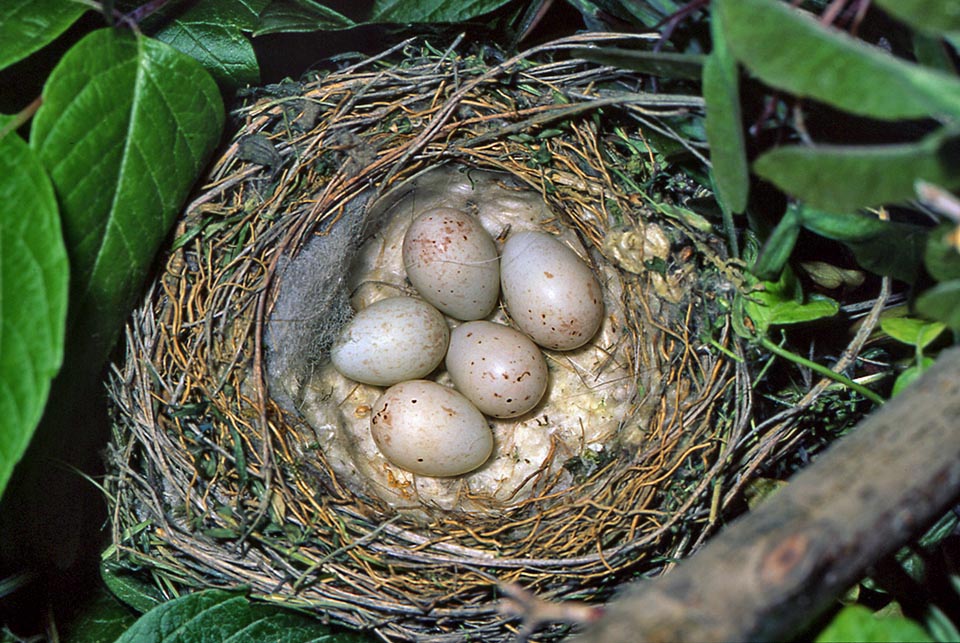
The Goldfinch nest is a perfectly circular cup not more than 6 cm wide that almost always goes unobserved. A construction made soft inside with down, hairs of animals, vegetal cotton and cobwebs, deep enough to contain 4-7 small eggs of cream colour slightly dotted by minute reddish polka dots © Museo Civico di Lentate sul Seveso
The construction is realized by the female only while the male carries most of the material necessary. The couple is monogamous during only the reproductive season. 4/7 rather small eggs are spawned, of cream colour lightly dotted by minute reddish pois in the widest part of the egg and the hatching lasts about 12/13 days, done only by the female. In some cases, the egg displays somewhat accentuated bluish nuances. Both parents dedicate to the care of the little ones that will take flight after about two weeks.
In this phase the Goldfinch becomes mainly insectivorous but as soon as the young develop the possibility to digest seeds and grains, the feeding modifies totally and becomes granivorous for the whole family.
The flying young follow their parents for some time even if the couple has started a new hatching.
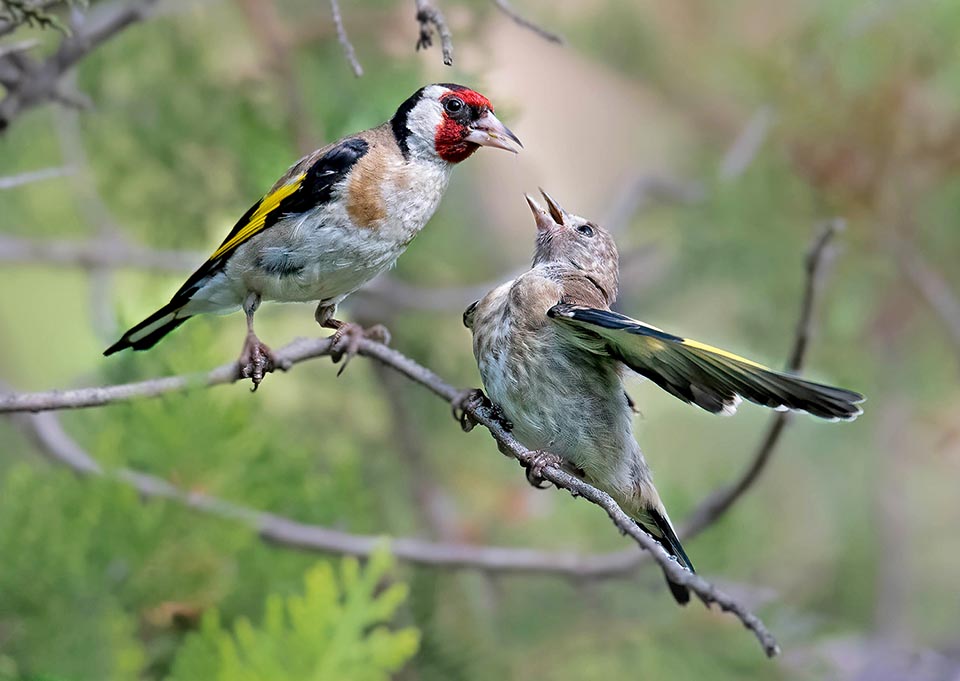
The young fly off at just two weeks of age, but follow the parents for long time, as they nourish them even if they have already started a new hatching © Jean-Marie Gradot
The Goldfinch is very prolific and usually does two hatchings per year and in some favourable years some couples do a third one. The good prolificacy is the antithesis of the lifespan of this species that in nature hardly exceeds a few years, like all members of the fringillids family.
This bird is very social in winter and often gathers in flocks, at times very big, mixed with bramblings and chaffinches and other fringillids. Often, during this season, it adapts to eat seeds even if refused during other seasons or at least fruits that are not as enticing as others. It can be seen often pecking also the achenes of the fruits of the planetrees, food that many species of fringillids do disdain.
Even though its populations are decreasing, Carduelis carduelis has still been listed since 2019 as “LC, Least Concern”, in the IUCN Red List of Threatened Species.
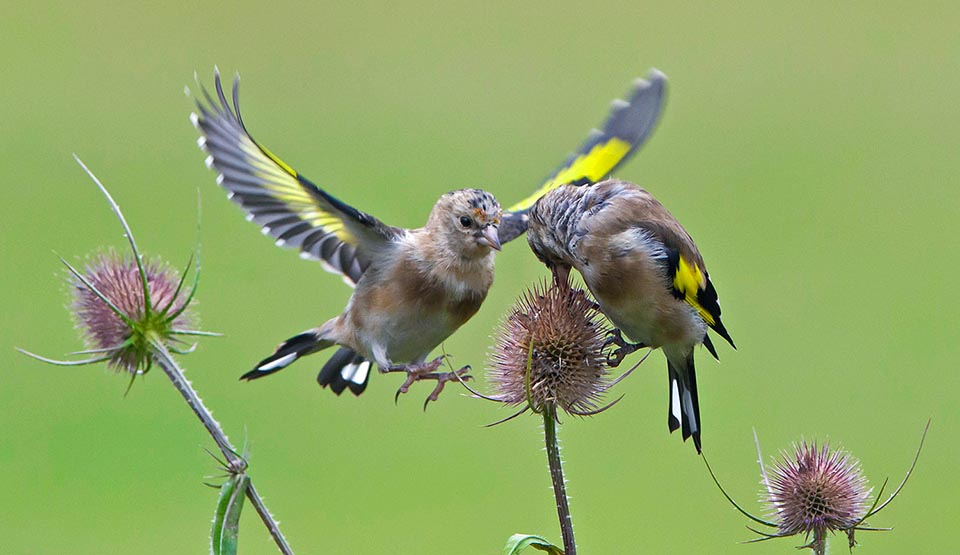
Here, older and now completely autonomous, have learn to take off the seeds from the thistle, their choice plant that gave name to the species © Phil Winter
The Goldfinch has always been appreciated by art. The music, painting, and poetry have often drawn on its figure and the works of famous artists have left us an indelible mark in the time. We recall only the Madonna of the Goldfinch by Raphael Sanzio as a memento for those who have remembered it in their art opuses.
A last anecdote based on an Anglo-Saxon play of words. In England, a grouping of several Goldfinches is called charm. A nice joke taken some years ago from the Daily Telegraph in the United Kingdom played in this term, cited: ” Two may be a charm, but even to spot one is joy itself! ”
Synonyms
Fringilla carduelis Linnaeus, 1758.
→ To appreciate the biodiversity within PASSERIFORMES please click here.
